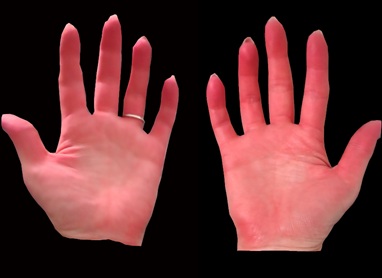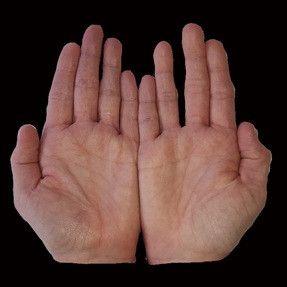
Palmar Erythema Associated with Natalizumab in a Patient with Multiple Sclerosis
*Corresponding Author(s):
Dédée F MurrellDepartment Of Medicine, University Of New South Wales, Sydney, NSW, Australia
Tel:+612 95985800,
Fax:+612 95985801
Email:d.murrell@unsw.edu.au
Case Presentation
A 38-year-old woman was referred to the Dermatology Outpatient Clinic with an 8-month history of painless, intermittent, self-resolving bilateral palmar erythema (Figures 1&2). Her medical history was significant for Multiple Sclerosis (MS), recurrent urinary tract infection, complex regional pain syndrome of the left leg, and hypertension. She had been receiving monthly natalizumab infusions for the treatment of MS for 13 months. Her only known drug allergy was Penicillin, which resulted in a generalised skin rash.
 Figure 1: Episode of palmar erythema occurring since commencing natalizumab treatment for Multiple Sclerosis.
Figure 1: Episode of palmar erythema occurring since commencing natalizumab treatment for Multiple Sclerosis.
 Figure 2: Normal palms of the patient while on natalizumab treatment for multiple sclerosis.
Figure 2: Normal palms of the patient while on natalizumab treatment for multiple sclerosis.
The first onset of palmar erythema occurred after the 5th dose of natalizumab, and each episode lasted between 30 minutes to a few hours, taking place at irregular frequencies. There were no other associated dermatoses or systemic symptoms. Her full blood count, electrolytes, urea, liver and thyroid function tests, and iron studies were unremarkable. The natalizumab infusions were continued because there were no other side effects.
MS is a chronic, auto-immune disorder characterised by inflammatory demyelination of the Central Nervous System (CNS) [1]. It is often diagnosed in young adults aged between 20 to 40 years and affects women 2-3 times more than men [1]. Currently, there are various disease-modifying, and immunosuppressive therapies available, each with their own side effect profile [2].
Natalizumab is a humanised monoclonal antibody which binds to the α4 subunit of α4β1 and α4β7 integrins expressed in leukocytes, inhibiting its interaction with the Vascular Cell Adhesion Molecule-1 (VCAM-1) receptor on endothelial cells [2]. This prevents the migration of leukocytes into the CNS, reducing inflammation [2]. The adverse effects associated with natalizumab include progressive multifocal leukoencephalopathy, urinary tract infection, urticaria, anaphylaxis, dizziness, arthralgia, liver injury, pneumonitis and recurrent vaginitis [3,4]. Flushing has been reported but only affecting the face during the infusion [5].
Herein we report a novel case of a young female with MS who developed intermittent, isolated palmar erythema without urticaria or other signs of hypersensitivity since the commencement of monthly natalizumab infusions for the treatment of MS. As each medication has its own adverse effect profile, we highlight the importance for risk-benefit analyses to aid in the decision-making process regarding treatment course for each patient.
Declaration
The patient reported in this case report has given informed consent to the use and publication of her de-identified photographs. Appreciation to Oliver GC Murrell for his assistance with the photographs.
Authors’ Contributions
DFM- Diagnosis of the patient, editing of manuscript; TJN – Writing of the original manuscript.
Conflict of Interest
None
Funding Source
None
References
- Delbue S, Comar M, Ferrante P (2017) Natalizumab treatment of multiple sclerosis: new insights. Immunotherapy 9: 157-171.
- McGinley MP, Goldschmidt CH, Rae-Grant AD (2021) Diagnosis and Treatment of Multiple Sclerosis: A Review. JAMA 325: 765-779.
- Giacoppo S, Ruscica M, Grimaldi LM, Bramanti P, Mazzon E (2017) The Italian Pharmacovigilance Program: An Observational Study of Adverse Effects of Natalizumab in Multiple Sclerosis Therapy. Med Sci Monit 23: 4230-4240.
- Kaninia S, Edey AJ, Maskell NA, Rice CM (2022) Natalizumab-induced pneumonitis. J Neurol 269: 1688-1690.
- Loonstra FC, van Rossum JA, van Kempen ZLE, Rispens T, Uitdehaag BMJ, et al. Infusion-related events during natalizumab: No need for post-infusion monitoring. Multiple Sclerosis Journal 26: 1590-1593.
Citation: Ng TJ, Murrell DF (2023) Palmar Erythema Associated with Natalizumab in a Patient with Multiple Sclerosis. J Clin Dermatol Ther 9: 0133.
Copyright: © 2024 Dédée F Murrell, et al. This is an open-access article distributed under the terms of the Creative Commons Attribution License, which permits unrestricted use, distribution, and reproduction in any medium, provided the original author and source are credited.

